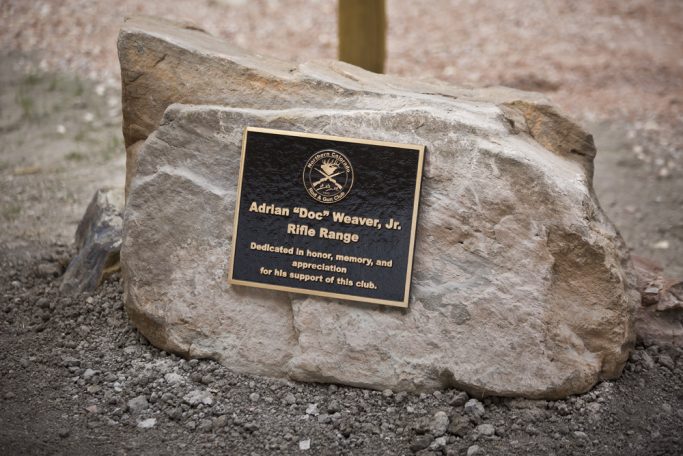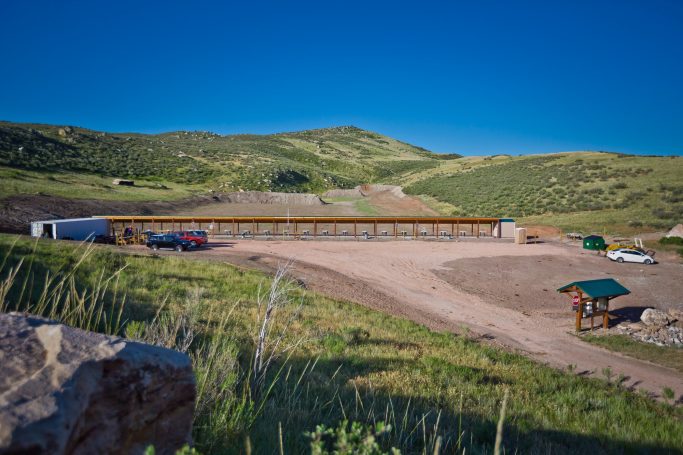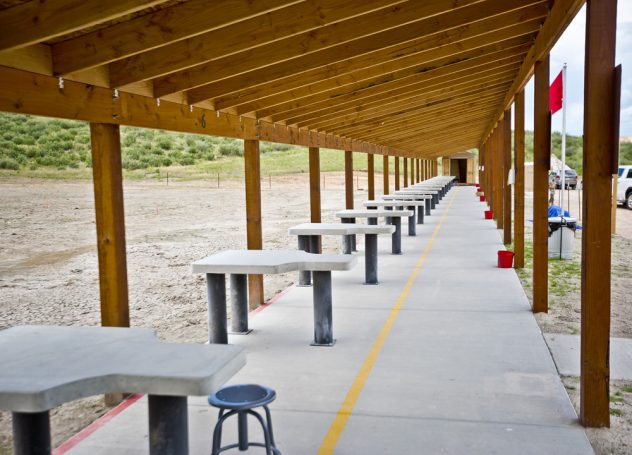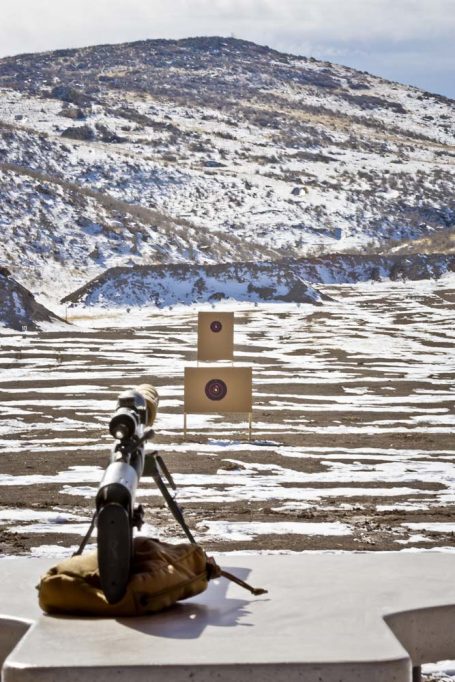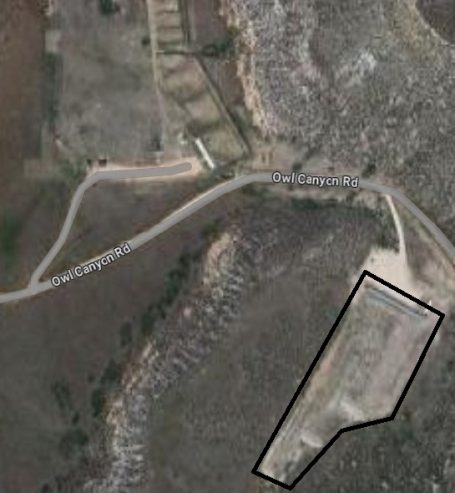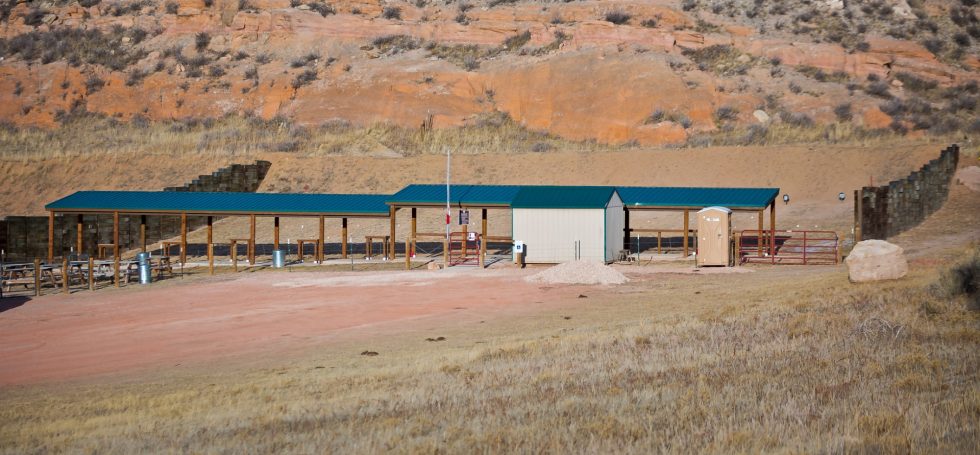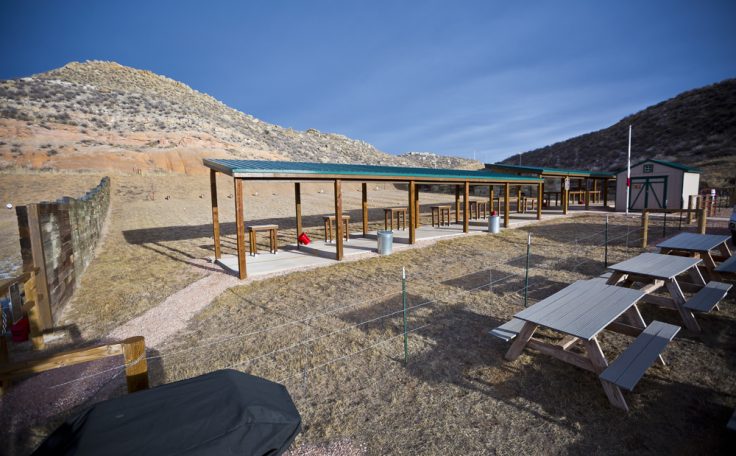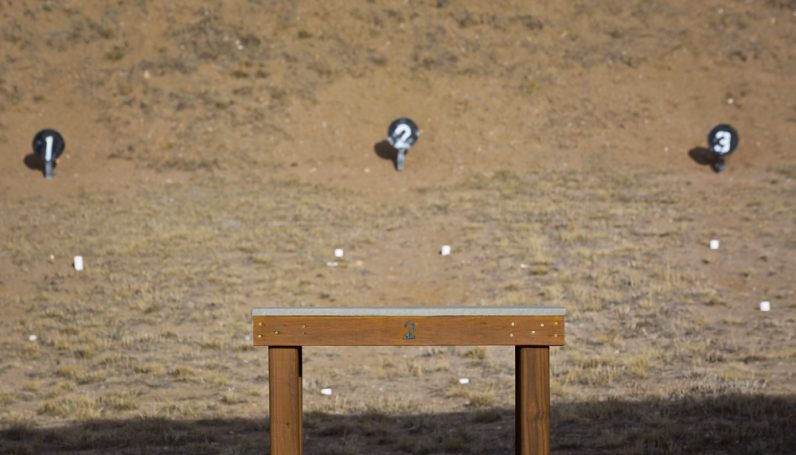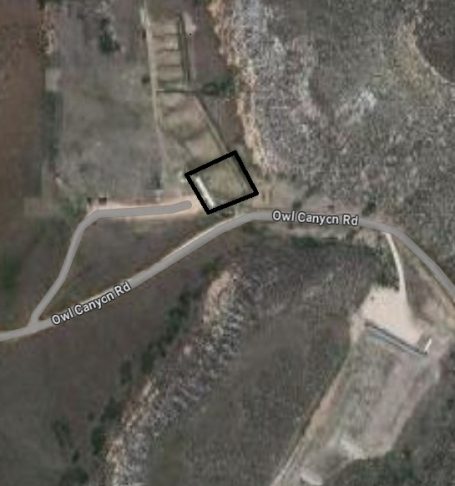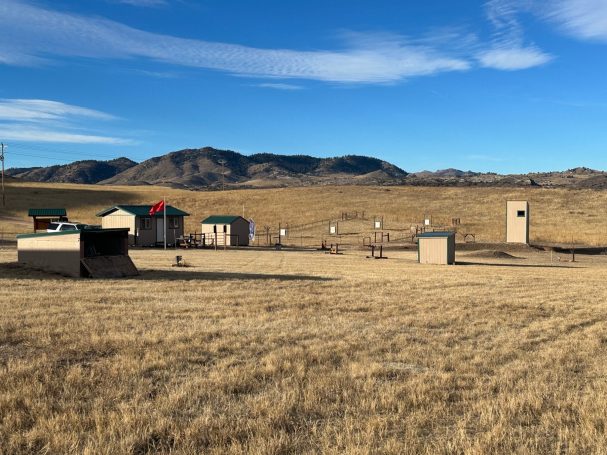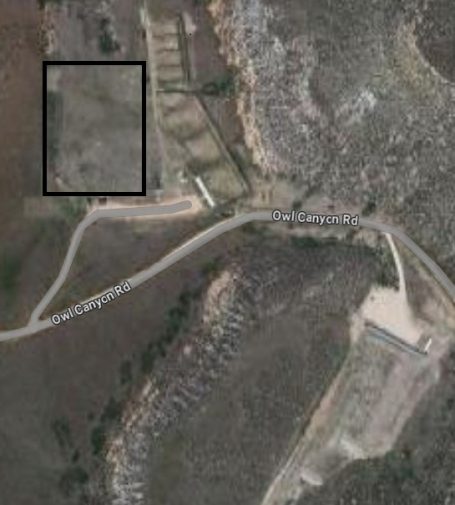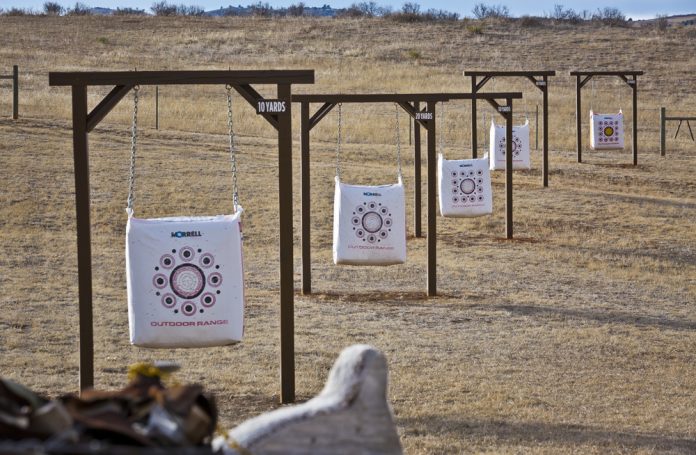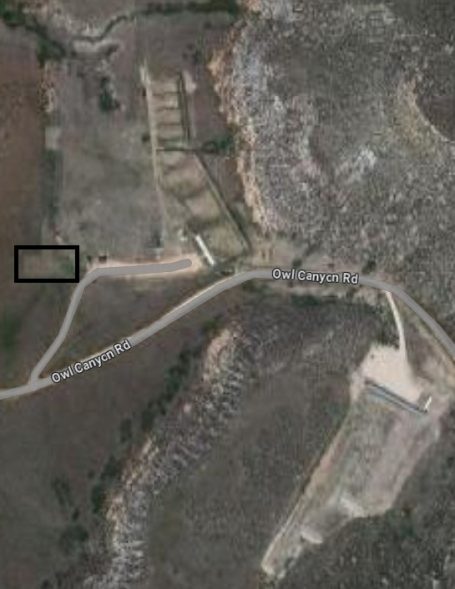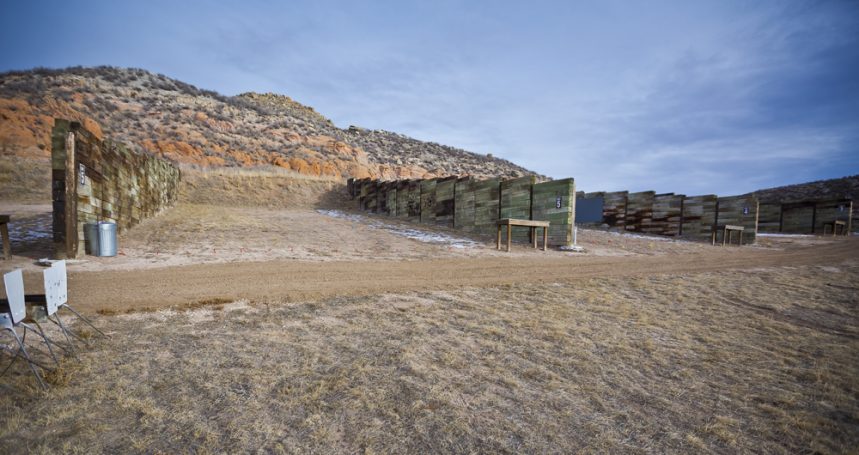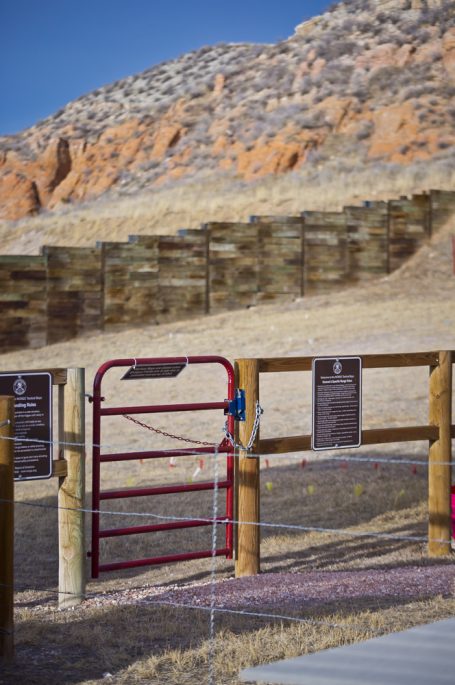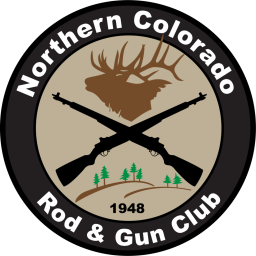The Ranges
Adrian "Doc" Weaver, Jr. Rifle Range
The Rifle Range has twenty covered firing stations with concrete tables to provide a solid shooting platform. All lanes use pre-made target stands that can be placed at various, pre-set distances.
Lanes #1 through #10 support target stand placement at 7, 10, 15, 20, 25, 50, 75, and 100 yards. In addition to rifle use, handguns may also be used on these lanes. Lanes #11 through #15 support target stand placement at 25, 50, 75, 100, and 150 yards. Lanes #15 through #20 support target stand placement at 25, 50, 75, 100, 150, and 200 yards.
All shooting lanes on the rifle range have fixed, steel gong lane markers that you can shoot. Please note that you are expressly forbidden from shooting the steel lane markers on Lanes #1 through #10 with any ammunition that exceeds 3,000 fps (this includes most centerfire rifle ammunition and all standard .223, 5.56, and 7.62 cartridges).
Member sheds are placed at each end of the firing line and contain chairs, pre-made target stands, sand bags, and first aid supplies.
Specific Range Rules – Rifle Range
- Rifles allowed on all shooting lanes. Handguns and shotguns allowed on lanes 1 – 10 only.
- Pistol Caliber Carbines (PCCs) are allowed on the Rifle Range.
- Fully automatic, echo triggers, burst, or bump firing is not allowed.
- You can shoot the numbered steel lane markers (muzzle velocity must be less than 3,000 fps on lanes 1 - 10).
- Raise range flag when range is in use. Lower range flag when range is not in use.
- Communicate with all shooters when range is HOT and when range is COLD. Double check!
- When range is HOT, you may handle and discharge your firearm. Stay behind red firing line.
- When range is COLD, do not touch firearm, magazine, etc. Stay behind yellow ready line.
- SAFE your firearm before going COLD. Remove magazine, empty cylinder, open action and leave facing up, point muzzle downrange, engage safety (if applicable), and bench firearm.
- Yell CEASE FIRE if you believe an unsafe condition exists or a safety infraction has occurred.
- If you hear CEASE FIRE, stop firing, keep muzzle pointed downrange, and await instructions.
- Armor piercing, tracer, explosive, or incendiary ammunition and targets are prohibited.
- Shoot only in your designated lane (no cross shooting). Know where others are at all times.
- Shoot only at authorized targets—no glass, clays, loose particle board, rocks, or metal objects, except commercial steel targets placed at least 25 yards in front of firing line.
- Do not shoot at target frames, holders, guardrails, posts, cover, livestock, wildlife, etc.
- Keep your range clean—pick up spent casings, misfired ammunition, used targets, and trash.
- Failure to observe these rules is cause for suspension or expulsion from the Club.
Pistol Range
The Pistol Range has ten covered firing stations and shooting benches for each station. Lanes #1 through #5 have reduced-width benches to allow for drawing from a holster. And, the shooting bench on Lane #7 is set at a lower height to accommodate shooters with disabilities as well as anyone who prefers a lower table height.
All lanes accommodate the pre-made target stands that can be placed at distances of 7, 10, 15, 20, and 25 yards. Additionally, steel gong lane markers, which can also be used as targets, are placed at 35 yards.
A member shed containing chairs, pre-made target stands, sand bags, and first aid supplies is located at the entrance to the Pistol Range.
Specific Range Rules – Pistol Range
- Handguns only—semi-auto, revolver, air, black powder, etc. No rifles or shotguns.
- Pistol Caliber Carbines (PCCs) and braces of any type are not allowed on the Pistol Range.
- Raise range flag when range is in use. Lower range flag when range is not in use.
- Communicate with all shooters when range is HOT and when range is COLD. Double check!
- When range is HOT, you may handle and discharge your firearm. Stay behind red firing line.
- When range is COLD, do not touch firearm, magazine, etc. Stay behind yellow ready line.
- SAFE your firearm before going COLD. Remove magazine, empty cylinder, open action and leave facing up, point muzzle downrange, engage safety (if applicable), and bench firearm.
- Yell CEASE FIRE if you believe an unsafe condition exists or a safety infraction has occurred.
- If you hear CEASE FIRE, stop firing, keep muzzle pointed downrange, and await instructions.
- Armor piercing, tracer, explosive, or incendiary ammunition and targets are prohibited.
- Shoot only in your designated lane (no cross shooting). Know where others are at all times.
- Shoot only at pre-made cardboard targets or commercial steel at base of backstop berm.
- Do not shoot at target frames, holders, guardrails, posts, cover, livestock, wildlife, etc.
- Drawing from holsters is allowed on shooting stations 1 through 5 only.
- Keep your range clean—pick up spent casings, misfired ammunition, used targets, and trash.
- Failure to observe these rules is cause for suspension or expulsion from the Club.
Shotgun Fields
The NCRGC Shotgun fields contain one Skeet and one Trap field (refer to the NCRGC calendar for scheduled public Skeet and Trap events), and an area where members can throw their own clay targets. Members are allowed to bring their own throwers and there is a fixed manual thrower and hand throwers available for member use.
Always raise the Range Flag by the main gate to the Shotgun Field when using the manual throwing area and lower the flag when you are done.
There is a bin on the deck of the manual throwing area that may contain clay targets for Members and their guests' use. Unbroken clays must be collected after you are done shooting. Unbroken clays should be saved or, if club provided clays are being used, returned to the clay target bin.
Due to the possibility of shot overspray, the manual throwing area CANNOT be used while:
- Skeet or Trap fields are in use.
- Tactical Bays 3 through 6 are in use.
- 3D Archery field (North of Tactical Bay 6) is in use.
The manual throwing areas CAN be used when Tactical Bays 1 and 2 are being used.
Ranges are available on a first-come basis and scheduled NCRGC events will always take precedence. Be sure to check the NCRGC calendar before your visit to help ensure that there are no surprises when you arrive.
Information about Skeet and Trap events can be found on the Shotgun Discipline page.
Specific Range Rules – Shotgun Fields
- Use the manual clay throwers at your own risk as they can cause serious injury.
- Read the operating instructions and warnings located in the clay storage box before use.
- Keep hands and body outside of the throwing arm path indicator areas.
- Load the trap magazine from the rear of the trap.
- Shoot from the area to the left of the thrower on the platform.
- Be aware of your line of fire and do not shoot the sheds.
- Utilize two people for a sitting-style thrower and one or two people for post-style thrower.
- Watch out for scatter pieces that result from cracked or broken targets.
- When finished, secure cover on thrower, pick up all broken clays larger than a quarter and put them in the trash, and place unbroken clays in the clay storage box.
- Failure to observe these rules is cause for suspension or expulsion from the club.
Specific Range Rules – Manual Throwers
- Shotguns only with fixed stocks and target loads 7 ½ – 9 shot only (no slugs).
- Shotgun Fields (Skeet and Trap) are closed when Tactical Bays are in use due to potential overspray of shot. Manual Thrower can be used when Tactical Bays 1 and 2 are in use.
- Raise range flag when range is in use. Lower range flag when range is not in use.
- Communicate with all shooters when range is HOT and when range is COLD. Double check!
- Keep actions/breaches open when not on a shooting station. Reopen after shooting.
- Do not load shotgun until you are on your station. Load from standing position.
- Never pass in front of Skeet or Trap houses when range is HOT.
- Yell CEASE FIRE if you believe an unsafe condition exists or a safety infraction has occurred.
- If you hear CEASE FIRE, stop firing, keep muzzle pointed downrange, and await instructions.
- Armor piercing, tracer, explosive, or incendiary ammunition and targets are prohibited.
- Do not shoot at target frames, holders, guardrails, posts, cover, livestock, wildlife, et
- Keep your range clean—pick up spent casings, misfired ammunition, used targets, and trash.
- Failure to observe these rules is cause for suspension or expulsion from the Club.
Archery Range
The Archery Range has five firing stations with stationary targets at 10, 20, 30, 40, and 50 yards.
Specific Range Rules – Archery Range
- Firearms are not allowed on the Archery Range.
- Raise range flag when range is in use. Lower range flag when range is not in use.
- Yell CEASE FIRE if you believe an unsafe condition exists or a safety infraction has occurred.
- If you hear CEASE FIRE, stop firing, keep arrow pointed downrange, and await instructions.
- Never use alcohol or drugs before or while shooting.
- Shoot only at designated targets from designated firing positions.
- Keep your range clean—pick up used targets and trash.
- Field point target tips only. Broadhead arrows are not allowed as they damage the targets.
- Only authorized personnel can move targets.
- Do not nock an arrow until you are ready to draw and shoot.
- Do not draw your bow until you have identified your shot point and are ready to shoot.
- For release shooters, do not place your finger near the trigger until your pin is on the shot point of your target.
- Archery is a silent sport and so are most archers. Pay attention to signs and arrows to avoid walking into an active shooting lane.
- Failure to observe these rules is cause for suspension or expulsion from the Club.
Tactical Bays
The Club has six Tactical Bays. While Tactical Bay #3 through #6 are exclusively reserved for use during sanctioned events (such as Steel Challenge, Defensive Pistol, Rimfire Challenge, First Shots, Hunter's Education, etc.), Bays #1 and #2 are available for use by members who have completed the Tactical Bay Certification. Activities allowed in the Tactical Bays include drawing from a holster, crossing the firing line, engaging multiple targets, rapid fire, transition drills, various shooting positions, shooting on the move, etc.
Rifles and shotguns may not be used in any Tactical Bay except when specifically allowed or called for in the course of fire during a sanctioned event. Member use of Tactical Bays #1 and #2 is on a first-come basis unless a sanctioned event is taking place. Be sure to check the NCRGC calendar as sanctioned events take priority over all other use.
Due to the possibility of shot overspray from the Skeet and Trap fields, Member use of Tactical Bays #1 and #2 is prohibited while the Skeet and Trap fields are in use.
Specific Range Rules – Tactical Bays
- Members are allowed to use Tactical Bays 1 and 2 during non-sanctioned events providing they are certified via the Club’s website. Keep a copy of the certification on you at all times.
- Tactical Bays are closed when Shotgun Fields (Skeet and Trap) are in use due to potential overspray of shot. Manual Thrower can be used when Tactical Bays 1 and 2 are in use.
- Activities allowed include drawing from a holster, crossing the firing line, engaging multiple targets, rapid fire, transition drills, various shooting positions, shooting on the move, etc.
- Handguns only—semi-auto, revolver, air, black powder, etc. No rifles or shotguns.
- Range Safety Rules and Gun Handling Rules apply to the use of the Tactical Bays.
- Only one active shooter at a time may use the bay. Know where others are at all times.
- Raise range flag when range is in use. Lower range flag when range is not in use.
- Communicate with all shooters when range is HOT and when range is COLD. Double check!
- Yell CEASE FIRE if you believe an unsafe condition exists or a safety infraction has occurred.
- If you hear CEASE FIRE, stop firing, keep muzzle pointed downrange, and await instructions.
- Armor piercing, tracer, explosive, or incendiary ammunition and targets are prohibited.
- Do not shoot at target frames, holders, guardrails, posts, cover, livestock, wildlife, etc.
- Keep your range clean—pick up spent casings, misfired ammunition, used targets, and trash.
- Failure to observe these rules is cause for suspension or expulsion from the Club.
Range Flags
Always remember to raise the range flag when the range is in use and lower the range flag when the range is not in use. If you are the first one on a range, please raise it. If you are the last one to leave, please lower it.
Range flags DO NOT not indicate whether or not a range is HOT or COLD. Please communicate with others upon your arrival to determine if the range is HOT or COLD.
Here are the steps for raising and securing a range flag:
- Undo the bungee cord securing the flag and help the flag to hang naturally.
- Undo the rope (halyard) that is wrapped around the cleat. Do not untie the knot in the halyard as it will run up and off the pulley.
- Raise the flag to the top of the pole by pulling on the halyard.
- Wrap the excess halyard around the cleat and secure it with the bungee cord.
- If you are the last person leaving the range, lower the flag, wrap it around the flagpole, and secure it with the bungee cord.
© 2024 NCRGC. All rights reserved.
Pictures on this web site are courtesy of NCRGC members and Ben Price, AdSortium Media.
We need your consent to load the translations
We use a third-party service to translate the website content that may collect data about your activity. Please review the details in the privacy policy and accept the service to view the translations.
